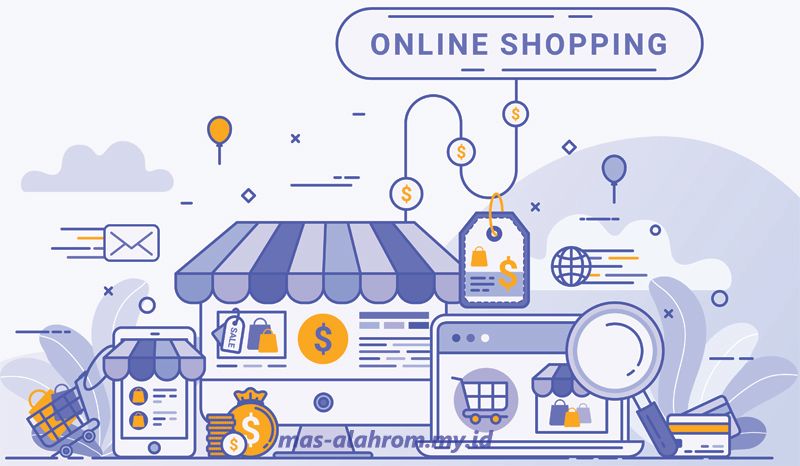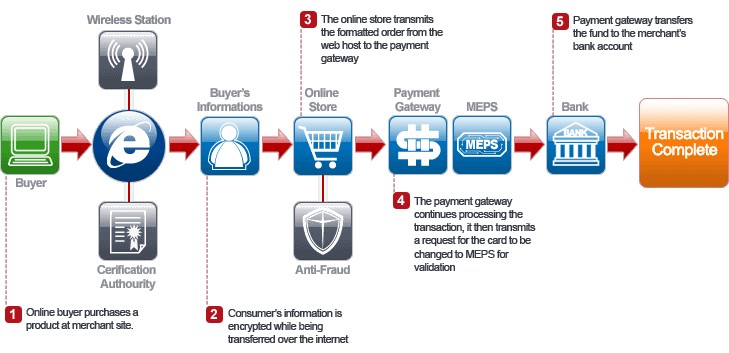The existence of the industrial revolution 4.0 greatly influenced developments in various fields, especially in the fields of telecommunications and trade. One of the most pronounced impacts of the industrial revolution 4.0 is the emergence of online shops and startups engaged in online services.
Basic Concepts of E-commerce
Online trade (E-commerce) is buying and selling goods and services through electronic networks. Currently, online trading is not limited to buying and selling activities, but also sending funds or data through electronic networks as well, like the CRM Software. However, not all trade via the internet is included in E-commerce. Some of the characteristics of E-commerce, including the following.
- There is Automation
In online trading, everything is done automatically, not manually as before. This includes delivery of goods and payments that have been made automatically.
- There is integration in one buying and selling process
With an integrated process in one buying and selling activity, it can increase the efficiency and effectiveness of buying and selling activities.
- Publication (Publishing)
In online trading, promotion is also carried out online or through the internet network. Consumers can see it directly from the electronic catalog displayed by merchants, as well as through social media.
- Interaction
Every transaction in online trading, there is an exchange of information between traders and buyers which is also supported by various applications that will reduce data errors for both buyers and traders. Because errors in the existing data when buying and selling occur, can be detrimental to both parties, namely traders and buyers.
- Transactions
In online trading transactions are carried out indirectly between buyers and traders. Especially in the payment process. The payment process for online trading involves other parties, such as banks, paypal, webmoney aplication, and so on.
- There is a product delivery service
Delivery of goods or services in online trading is not carried out by the merchant himself, usually traders will involve other parties as product delivery services that he offers, such as, FeDex, and other freight forwarding expeditions.
E-commerce Components
In contrast to traditional or offline trading, online trading (E-commerce) has broader components, including the following.
- Customers are internet users who are very potential target markets to offer the products they produce, as well as information related to the products to be marketed, for example, the advantages or advantages of the products they make.
- Seller is a party that offers products either directly or through a website or through a marketplace.
- Electronic Data Interchange (EDI) is a process of exchanging data between various organizations, which aims to facilitate and bind trade between trading partners or businesses. EDI consists of elements that ensure that the trading process with consumers runs smoothly without harming either party.
- Digital Currency is a startup or software that allows electronic transactions to occur, such as paypal, bank aplication, webmoney transfer aplication and others.
- Electronic Catalog is part of an application that allows sellers to inform the products they sell, and consumers can see the products and specifications of the products being sold. The Electronic Catalog is generally in the form of an interactive www site, global presence, hypertextuality, and easy to update.
- Intranets and extranets. An intranet is an internet collection that belongs to a member of a specific group, and only that group can access it. At the same time, an extranet is an area on the internet that people outside the group members from the intranet with certain authority can access. For example, everyone can access and shop on the Amazon website without downloading the application, but there are limited features. It’s different if we shop or open directly from the application.
Advantages and Disadvantages of E-commerce
After knowing about the meaning and components, there are advantages and disadvantages that you should know about the e-commerce business.
The advantages of E-commerce in the business world
- Easier and Simpler Organization
Organizing products to promote or offer is more accessible and simpler. We no longer need to display catalogs or make catalog books for the products we want to offer physically. It is enough to make pictures of the products that we will offer and display them on social media by providing a description of the goods or services offered. In addition, the number of employees needed will also decrease, because we only need a few employees to handle online orders and employees who handle goods delivery.
- Ease of Managing Goods
If we sell goods online, for example, by opening an online store aplication or using website, we will not have to bother with managing goods and warehousing because the site management system provides them. With the management system provided by the site, it makes it easier for consumers to see existing stock of goods and makes it easier for traders to manage their merchandise.
- More Focused Service
The management system available on the site or website makes it easy for businesses or traders to accommodate all existing orders and helps traders to provide faster and better service to buyers or consumers. So traders will focus more on serving consumers without the need to think about how to manage the ordering process from consumers.
- Easier Market Research
By selling online through online sites and through social media, it makes it easier for traders to conduct market research about what products are currently needed, and are in demand by consumers today. This can help traders to create sales strategies that can increase their sales results.
- Cheap Trading Fees
As we know, many sites selling online offer services or cooperation at a very cheap or even no cost. In addition, the costs for creating a website or through social media are also affordable. Even traders can use websites or blogs for free on certain sites.
- Ease of Selecting Target Markets
An internet network that has a very wide coverage, makes it easier for traders who trade online to reach potential target markets. There are several ways you can do this, including offering products in various forums or through social media, creating free or paid advertisements with certain keywords on the website, or on available online trading sites.
- Unlimited Space and Time
The ability of the internet which can be accessed anywhere and anytime, gives advantages for online traders to market their goods and services.
Disadvantages and constraints of e-commerce
The increasing development of E-commerce is inseparable from various constraints and deficiencies. Some of the shortcomings and constraints of E-commerce are as follows.
- Supervision of online sales has not been maximized, whether it is done by online sites, social media or the government, especially in Indonesia. This is due to the vast territory of Indonesia, infrastructure that is still not supportive and human resources that are considered not ready to face developments, especially during the current industrial revolution 4.0.
- There is still no standardization of products and services, so that currently there are still many consumers who choose based on price alone, not based on product quality. This can provide loopholes for business actors or traders to enter goods that do not comply with the standards set by the government.
- There is no clear legal force for both traders and buyers, resulting in cybercrimes that are difficult to avoid.
Benefits of Online Trading (E-commerce)
- Make changes quickly.
If an error occurs in the product catalog, both gradients, and words in the product catalog, it will be easy for the merchant to fix it, and changes can be made quickly without any problems.
- Define a specific target demographic
Online trading by utilizing the internet network makes it easier for traders to reach certain target demographics that can be adjusted to the products offered. The intended demographic targets are gender, age, and location. It can even target specific income levels, educational levels, and occupations.
- Many media choices
The media for online trading are now increasingly diverse. Such as through social media, live streaming video, email, and blogging.
- Effective liaison between marketers and consumers
With online trading, the relationship between consumers and marketers can be more easily established (both product sellers and direct producers) and benefits both parties. Consumers are facilitated to obtain information about the product they are looking for. Only by typing certain keywords in the search engine column on the internet related to the product you are looking for. Then detailed information on the product will appear, both how to get it and the parties who sell it, both from direct manufacturers and through sellers, such as suppliers, wholesalers, shops, and so on.
- Can change the potential target market easily and quickly. This is very important in the product marketing process.
Activity Flow in E-commerce
In e-commerce, there is a general flow that cannot be separated from four important components. The four important components, which is, sellers, consumers, technology, and computer networks (internet).
Principles of E-commerce Sales
In general, the principles of e-commerce sales are the same as conventional trade, the difference is that activities are carried out online and digitally (without involving face-to-face contact between sellers and buyers). Some important points in the working principles of e-commerce, include the following.
- Some products are traded, both goods and services.
- There are consumers.
- There is a service system through an application.
- There is a process of sending goods or services that involves an expedition for the delivery of goods or services.
- Availability of handling logistical problems (stock of goods) which helps traders to meet consumer demand.
E-commerce Applications in Schools
E-commerce applications in schools aim to market products produced by students and are expected to develop to a global level. There are three stages for applying e-commerce in schools, which is.
- Aim for potential markets, namely markets where demand for products already exists, but there are not many competitors and it is adjusted to the potential of existing schools.
- Determination of products, namely producing products that make people addicted, and wanting more and more, and finally packaging and branding, namely making packaging that is beautiful inside and out without hiding the school’s identity and superior potential.
- Determination of school promotion media in general can be through the marketplace or social media. E-commerce in schools can be done in groups or individually. If in groups it can be done during craft lessons with children making their own products or selling school products. Each group is given a challenge with a minimum turnover of 50 dollars per week.
Not only the stages above, the application of e-commerce in schools also begins by preparing students with the stages below.
- Complete entrepreneurship learning facilities with learning media for craft development
- Peer tutor entrepreneur assistance
- Organize entrepreneurship training regularly
- Build space for online learning
- Building an entrepreneurship laboratory
- Establish an entrepreneurial community in schools
From the above stages it will create an entrepreneurial spirit for students for the future who can compete especially in the field of e-commerce entrepreneurship, because e-commerce can indirectly bring up the learning process through the real world, students learn to make reasonable goals and expectations, students not only learn theory from books, but absorb its implementation in the field, and build mutually beneficial access and networks. Changes in the character of students will appear by themselves because the required characters must appear in the application of e-commerce in schools, including the following.
- Emotional intelligence, needed in dealing with various consumer characters.
- Ability to manage time, able to do tasks based on priority.
- Communicative, the ability to use language socially can be accepted by all groups.
- Innovative, Having creativity in making innovations to products.
- Have a good attitude, a good attitude in increasing productivity.
- Financial skills, training the ability to manage money
- Courage, Building confidence, and building consumer trust.
Developing e-commerce applications in vocational schools can be developed through teaching factories and learning Creative Products and Entrepreneurship. In teaching factories, the products or services produced by students are in accordance with the advantages and potential of the vocational school area, such as coffee-hape products, cold brew, processed potatoes and workshops that can be used as a way for the development of e-commerce in schools with industrial standards.
Conclusion Online Business for Students
Teaching factory products/services are a huge opportunity for students because students, without them being creative in their products, but in terms of trade development and promotion can be used as a way to grow the entrepreneurial side that is really needed nowadays. This is seen from the potential for developing e-commerce, especially among teenagers.
The development of e-commerce in the teaching factory makes students’ vocational and trade skills more developed so that when they graduate from the competency side, expertise and trade can develop stronger.
In learning creative and entrepreneurship product subjects as well as programs accommodated by the Directorate of PSMK Indonesian students to develop e-commerce through the Entrepreneurial Printing School program, students and students are more independent in creating products, no longer seen as vocational like teaching factory. Still, they are more seen from the creative side, trade strategy and especially entrepreneurship in e-commerce.
They are free to make products according to their creativity or become resellers. However, the trading side of e-commerce is high, so even if they are only resellers, they can develop e-commerce optimally.

















